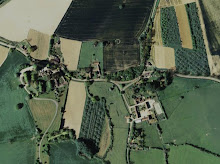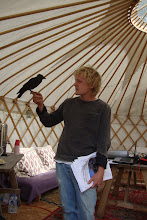.JPG)
This sequence shows Isaac helping me tackle a tree that we thought was in danger of splitting down its trunk. It had become very spreading, with a large weight of wood a long way from the crown. The trunk appeared to have a clear weak point as well.

By bringing the arms in, the tree would be much less likely to split in two. Fortunately Issac is trained to undertake this kind of major surgery. It makes you think what would have been involved before the days of chainsaws!
.JPG)
On the right of this shot you can see the water shoots I have partially cut and bent down horizontally to grow out and eventually replace the branches we have removed. This technique seems rather brutal and may increase chances of infection at these wounds, but the trees are remarkably resilient and thus it is a risk worth taking.

Here is a tree we didn't get to in time to save. It is now supported by the ends of its spreading branches and will gradually decay. I plan to leave it in-situ as a habitat feature of these wood-pasture ecosystems.

The blue trees have been pruned by Issac and myself in the last few weeks. The five pink trees were pruned by my friends during the pruning party I hosted last weekend. The two yellow trees are standing dead or have split and will be left to decay gracefully.
















.JPG)
.JPG)

.JPG)






.JPG)

.JPG)



